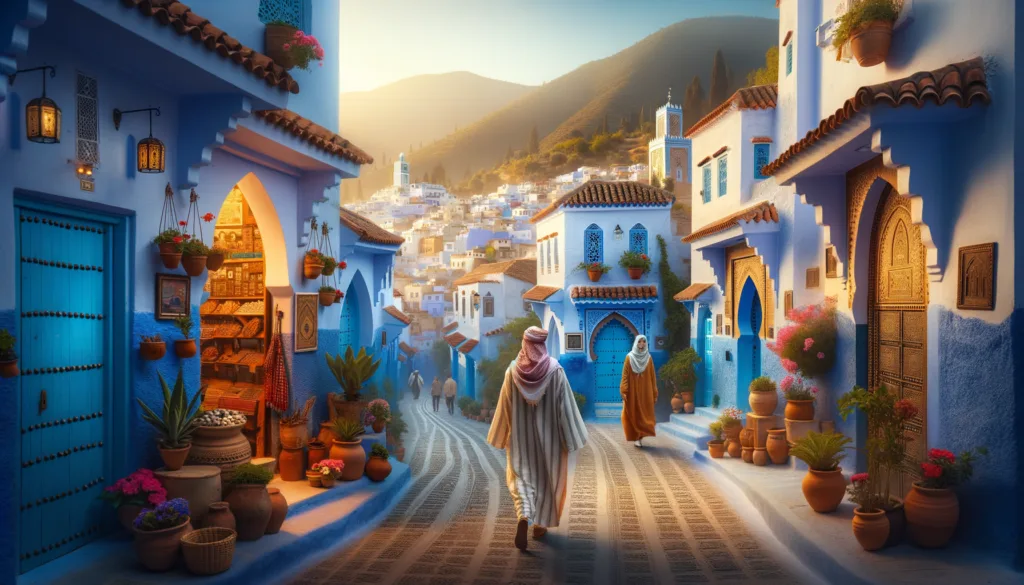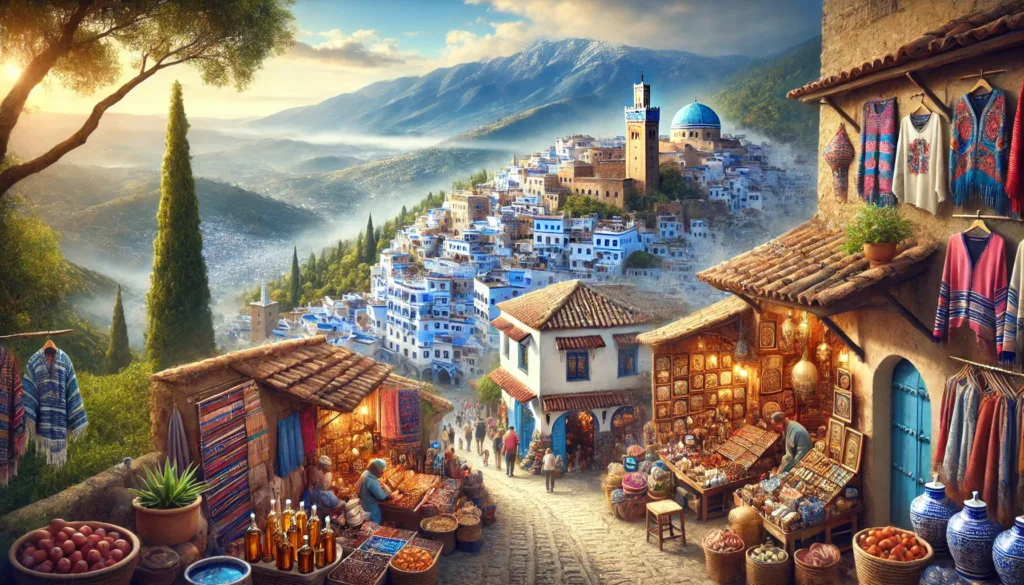
Hidden within the rugged Rif Mountains of northern Morocco lies a town that looks like it was plucked from a dream—Chefchaouen, the “Blue Pearl” of Morocco. Known for its vibrant blue-painted streets, old-world charm, and breathtaking natural surroundings, this enchanting town has become a favorite destination for travelers seeking culture, tranquility, and a touch of the surreal.
Chefchaouen’s deep cultural roots reflect a blend of Andalusian, Moorish, and Berber influences, making it a fascinating place to explore beyond its picturesque beauty. Its blue-washed walls and winding alleys create a peaceful, calming atmosphere, offering visitors a stark contrast to the bustling energy of cities like Marrakech or Fes.
Whether you’re an adventure seeker, a photography enthusiast, or simply someone looking for a unique and relaxing getaway, Chefchaouen is a Moroccan gem that deserves a spot on your travel list.
The Mesmerizing Blue Streets
A City Dipped in Blue
One of Chefchaouen’s most striking features is its overwhelmingly blue-painted medina. Walking through the town feels like stepping into an artist’s masterpiece, where every wall, staircase, and alleyway is drenched in shades of blue—from soft pastels to deep cobalt hues.
Theories Behind the Blue Color
A Spiritual & Cultural Symbol
Many believe that the blue color has religious and cultural significance. Some say it symbolizes the sky and heaven, serving as a reminder for the town’s Jewish and Muslim communities to maintain a spiritual connection.
A Natural Mosquito Repellent
Another prevailing theory suggests that the blue paint helps ward off mosquitoes, a practical solution adopted by the residents over time. Whether or not this is scientifically proven, the cool tones certainly add to the town’s serene ambiance.
Mediterranean Influence
Some historians believe that the blue architecture was introduced by Jewish refugees fleeing the Spanish Inquisition in the 15th century. They brought with them a tradition of painting structures blue, a practice that eventually shaped the identity of Chefchaouen.
A Photographer’s Dream
Travelers, influencers, and photographers from around the world flock to Chefchaouen to capture its surreal beauty. Every corner offers an Instagram-worthy snapshot, from the intricate doorways and blue-tinted alleys to the contrasting bursts of color from flower pots and local crafts.
Whether you’re wandering aimlessly through the medina or setting up the perfect shot, Chefchaouen’s magical blue streets guarantee an unforgettable visual experience.
The Mesmerizing Blue Streets
The Signature Blue Walls of Chefchaouen
One of the most striking features of Chefchaouen is its enchanting blue-painted streets, a mesmerizing sight that distinguishes this Moroccan gem from any other city in the world. Walking through its charming alleys feels like stepping into a dreamscape—where every door, wall, and staircase is bathed in shades of azure, cobalt, and turquoise. The effect is both surreal and soothing, making it a paradise for photographers and travelers seeking aesthetic beauty.
Theories Behind the Iconic Blue Color
Symbolism and Spiritual Meaning
Some believe the blue shades symbolize spirituality, reflecting the sky and heaven. This theory is rooted in Jewish traditions, as refugees fleeing the Spanish Inquisition in the 15th century reportedly introduced the practice of painting the walls blue.
Practical Reasons: Mosquito Deterrent
A more practical explanation suggests that the blue paint helps keep mosquitoes away, as the color is thought to repel insects. Many locals embrace this belief and continue the tradition of repainting their homes and streets regularly.
Mediterranean Influence
Another idea links Chefchaouen’s blue hues to the wider Mediterranean culture, where blue is commonly associated with protection and good fortune. The practice might have origins in both Islamic and Andalusian design elements.
A Photographer’s Paradise
For photographers and social media influencers, Chefchaouen is a visual delight. Every turn offers another postcard-worthy view, whether it’s a strikingly blue passageway, a flower-draped window, or a traditional Moroccan door. The city’s soft natural lighting, particularly in the morning and late afternoon, enhances the enchanting effect, making it an Instagram hotspot.
Nature, Landmarks, and Scenic Views

The Rif Mountains: Nature’s Perfect Backdrop
Chefchaouen is nestled within the breathtaking Rif Mountains, providing visitors with a stunning natural backdrop. The area offers a variety of outdoor activities, including hiking, scenic viewpoints, and guided nature walks. The trails here are less crowded than those in other regions of Morocco, making it an excellent destination for those seeking solitude in nature.
The Spanish Mosque: The Best Panoramic Viewpoint
Perched on a hill overlooking the city, the Spanish Mosque offers one of the best panoramic views of Chefchaouen. The short hike up is worth every step, especially if you visit during sunrise or sunset when the golden light illuminates the blue city below, creating a truly magical sight. This is a great spot to pause, take in the beauty, and capture unforgettable photos.
The Kasbah Museum: A Dive into History and Culture
Located in the heart of the medina, the Kasbah Museum provides insight into the history and traditions of Chefchaouen. This well-preserved fortress houses a collection of artifacts, Andalusian gardens, and an old prison, giving visitors a glimpse into the city’s past. Climbing to the top of the Kasbah rewards you with another spectacular view of the medina.
Authentic Medina Experience & Local Shopping
Exploring the Medina’s Vibrant Souks
The bustling medina of Chefchaouen is an adventure in itself. Unlike the chaotic markets of larger Moroccan cities, Chefchaouen’s souks exude a more laid-back and welcoming atmosphere. Meandering through its narrow footpaths, you’ll encounter colorful stalls selling traditional handicrafts, fragrant spices, and souvenirs exclusive to the region.
Unique Handicrafts and Local Treasures
Wool Garments and Handwoven Blankets
One of Chefchaouen’s signature crafts is its high-quality wool products. Skilled artisans produce beautiful handwoven blankets, warm woolen cloaks known as djellabas, and intricate Berber designs—perfect souvenirs to take home.
Ceramics and Embroidered Textiles
Visitors can also find delicately hand-painted ceramics and embroidered textiles that showcase Moroccan craftsmanship. These items make for unique, authentic gifts and home décor souvenirs.
Natural Beauty Products: Argan Oil and Rose Water
Chefchaouen’s markets also offer natural beauty products, such as artisanal soaps, rose water, and high-quality argan oil, sourced from nearby regions of Morocco. These items are sought after for their nourishing properties and organic quality.
The Art of Bargaining: Shopping Like a Local
Bargaining is not just a transaction in Moroccan culture—it’s an art form and a part of the shopping experience. Vendors typically expect friendly negotiation, so don’t hesitate to engage in a little haggling. A good rule of thumb is to start at around half the asking price and work your way to a fair deal. Friendly banter and patience can often lead to surprising discounts!
Relaxation, Cuisine, and Travel Tips
A Peaceful Retreat
Unlike the bustling metropolises of Marrakech and Fes, Chefchaouen offers a serene escape. Its laid-back atmosphere, car-free medina, and cool mountainous air make it an ideal destination for travelers seeking relaxation. Whether you’re strolling through the quiet blue-washed streets or sipping mint tea at a rooftop café, Chefchaouen is a place where time slows down, allowing visitors to truly unwind.
Must-Try Moroccan Dishes
One of the highlights of visiting Chefchaouen is indulging in the region’s rich and flavorful cuisine. The town boasts a mix of Andalusian, Berber, and Moroccan influences that manifest in its food. Be sure to try:
Traditional Tagine
A slow-cooked stew prepared with lamb, chicken, or vegetables, infused with aromatic spices and served straight from a clay pot.
Couscous
A staple of Moroccan cuisine, typically served on Fridays, featuring steamed semolina grains topped with vegetables, chickpeas, and meat.
Local Goat Cheese
A specialty of the Rif region, this creamy and slightly tangy cheese is a must-try, especially when paired with fresh bread or olives.
Zaalouk
A delicious smoky eggplant and tomato dip, often served as a side dish with warm crusty bread.
Travel Essentials
Getting to Chefchaouen
The most common way to reach Chefchaouen is by road. Buses from major Moroccan cities like Tangier, Fes, or Casablanca offer convenient access. Private transfers and rental cars are also available for those who prefer a more flexible journey.
Best Accommodations
From charming riads tucked within the medina to guesthouses offering stunning mountain views, Chefchaouen has a range of accommodations to suit every traveler’s budget. Staying within the medina provides a more immersive experience in the town’s magical ambiance.
Ideal Times to Visit
The best times to explore Chefchaouen are during the spring (March-May) and autumn (September-November). These seasons provide pleasant weather, fewer crowds, and breathtaking sunsets reflecting off the blue-painted streets.
Etiquette Tips
Morocco is a culturally rich nation with deep-rooted customs. When visiting Chefchaouen, keep these travel etiquette tips in mind:
- Dress modestly, especially when exploring the medina.
- Ask permission before photographing locals or their shops.
- Learn a few basic Arabic or French phrases—”Shukran” (thank you) goes a long way!
- Respect prayer times and avoid loud behavior near mosques.
Conclusion
Chefchaouen is a destination that blends history, nature, culture, and tranquility into one unforgettable experience. Whether you’re marveling at the ethereal blue streets, savoring exquisite local cuisine, or hiking in the picturesque Rif Mountains, this Moroccan gem offers something truly special for every traveler.
For those looking to step off the beaten path, immerse themselves in a peaceful retreat, and capture a slice of Moroccan charm, Chefchaouen is a must-add to your travel list. Pack your camera, embrace the town’s slow pace, and let Chefchaouen leave an indelible mark on your soul.
Bon voyage!
FAQ
What makes Chefchaouen unique?
Chefchaouen, often called the “Blue Pearl” of Morocco, is known for its stunning blue-painted streets, relaxing atmosphere, and breathtaking location in the Rif Mountains. The combination of history, culture, and natural beauty makes it a must-visit destination.
Why are the streets of Chefchaouen painted blue?
There are several theories behind the iconic blue color. Some believe it helps to keep mosquitoes away, while others see it as a symbol of the sky, heaven, or the Mediterranean Sea. Regardless of the reason, the result is a mesmerizing and photogenic environment.
What are the best things to do in Chefchaouen?
Top activities include exploring the blue-painted Medina, visiting the Kasbah Museum, hiking to the Spanish Mosque for panoramic views, shopping for local handicrafts, and enjoying Moroccan cuisine at traditional cafes and restaurants.
How do I get to Chefchaouen?
Chefchaouen can be reached by bus, taxi, or car. Public buses are available from major cities like Fez and Tangier, while a private car or taxi offers more flexibility for your trip.
What is the best time to visit Chefchaouen?
The best time to visit is during the off-season to avoid large crowds. November is a great option as it provides a more authentic and peaceful experience while avoiding peak tourist seasons.
Is Chefchaouen safe for tourists?
Yes, Chefchaouen is generally considered safe for tourists. The town has a relaxed and welcoming atmosphere, but it’s always wise to take standard travel precautions, especially when exploring new areas.
What can I buy in the markets of Chefchaouen?
The Medina offers a variety of unique souvenirs, including woven blankets, wool garments, handmade crafts, and local spices. Bargaining is common in Moroccan markets, so don’t hesitate to negotiate prices.
Where are the best places to take photos in Chefchaouen?
Some of the best photography spots include the blue alleyways of the Medina, the Kasbah Museum, Plaza Uta El-Hammam, and the Spanish Mosque at sunset. Be mindful that some popular photo spots may charge a small fee.
What type of food should I try in Chefchaouen?
Local specialties include Moroccan couscous, tagine, tangia, goat cheese, and zaalouk (a warm Moroccan salad). Visiting lesser-known eateries can enhance your culinary experience.
Where should I stay in Chefchaouen?
Staying in a traditional riad, such as Dar Elrio, is highly recommended for an authentic and comfortable experience. Riads offer a charming and welcoming atmosphere with local hospitality.
Do I need to respect any cultural customs while visiting?
Yes, visitors should respect local customs by dressing modestly, asking permission before taking photos of residents, and being mindful of traditions. Engaging with locals politely and appreciating their culture enhances the travel experience.